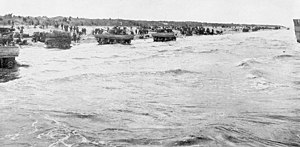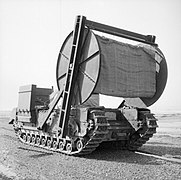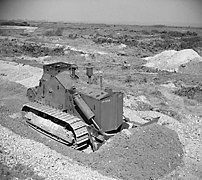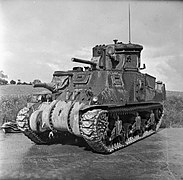Hobart's Funnies
This article needs additional citations for verification. (January 2012) |
| "Hobart's Funnies" | |
|---|---|
 Amphibious DD tanks await blowing of breaches in the sea wall on Utah Beach. This photo was taken shortly after H Hour. | |
| Type | Modified tank variations |
| Place of origin | United Kingdom |
| Service history | |
| In service | 1944–1945 |
| Used by | 79th Armoured Division or by specialists from the Royal Engineers |
| Wars | World War II |
| Production history | |
| Designer | Various |
| Designed | 1941–1944 |
| Manufacturer | Various |
Hobart's Funnies is the nickname given to a number of specialist armoured fighting vehicles derived from tanks operated during the Second World War by units of the 79th Armoured Division of the British Army or by specialists from the Royal Engineers.[1]
They were designed in light of problems that more standard tanks experienced during the amphibious
The vehicles converted were chiefly Churchill tanks, and American-supplied M4 Sherman tanks.
History
Plans to invade continental Europe were completely revised after the failure of the
Many of the ideas had already been tried, tested or were in experimental development both by Britain and other nations. For example, the Scorpion
By early 1944, Hobart could demonstrate to Generals
Montgomery considered that the US forces should use them. A third of the "funnies" were offered to the Americans of all the vehicles available, but take-up was minimal.[3] Eisenhower was in favour of the DD tanks but left the decision on the others to General Bradley. None of the other designs was used, because it was thought that they required specialised training and an additional support organisation. Also, the Americans were reluctant to make use of funnies based on the Churchill tank as they did not want the logistical complexity of adding another tank model to their inventory.[4]
Bradley requested 25 flail tanks and 100 Churchill Crocodiles shortly after the demonstration in February 1944 and the British War Office agreed to supply them as well as British-crewed AVREs. In the event though there was insufficient time to produce the vehicles and train the crews so on the day American forces were limited to DD tanks and their own Sherman bulldozer tanks and armoured bulldozers while 42 Assault Brigade instead of supporting the US beaches became a reserve for the British and Canadian beaches.[5]
In light of operations during the US landing on
Designs
The majority of the designs were modified forms of the
Among the many specialist vehicles and their attachments were:
The
- Bobbin: A reel of 10-foot (3.0 m) wide canvas cloth reinforced with steel poles carried in front of the tank and unrolled onto the ground to form a "path", so that following vehicles (and the deploying vehicle itself) would not sink into the soft ground of the beaches during the amphibious landing.
- Fascine: A bundle of wooden poles or rough brushwood lashed together with wires carried in front of the tank that could be released to fill a ditch or form a step. Metal pipes in the centre of the fascine allowed water to flow through.
- Small Box Girder: An assault bridge that was carried in front of the tank and could be dropped to span a 30-foot (9.1 m) gap in 30 seconds.
- Bullshorn Plough: A mine plough intended to excavate the ground in front of the tank, to expose and detonate any land mines.
- ' Double Onion': Two large demolition charges on a metal frame that could be placed against a concrete wall and detonated from a safe distance. The tank could place demolition charges at heights up to 12 feet. The tank was driven against a wall, the framework was lowered into the ground against the wall. The tank then backed up 100 feet laying out an electric detonating cable. The explosives were then detonated by the tank driver. It was the successor to the single-charge device "Carrot". Also called the "Jones Onion". A larger development was called "Goat".
Other vehicles included
- ARK (Armoured Ramp Carrier) was a turretless Churchill tank that had extendable ramps at each end; other vehicles could drive up the ramps and over the vehicle to scale obstacles, effectively functioning as a mobile bridge.
- Crab: A modified Sherman tank equipped with a mine flail, a rotating cylinder of weighted chains that exploded mines in the path of the tank.
- DD tank (from "Duplex Drive"): An amphibious version of the Sherman created by fitted M4A1 and M4A4 with a large watertight canvas housing. This increased displacement and so the tank was able to float and reach the shore after being launched from a landing craft up to several miles from the beach. They were intended to give support to the first waves of infantry that attacked the beaches. A Valentine tank version was developed first but used for training only.
- Armoured bulldozer: A conventional Caterpillar D7 bulldozer fitted with armour to protect the driver and the engine. Their job was to clear the invasion beaches of obstacles and to make roads accessible by clearing rubble and filling in bomb craters. Conversions were carried out by Caterpillar importer Jack Olding & Company Ltd of Hatfield.
- Centaur Bulldozer: A Centaur tankwith the turret removed and fitted with a simple winch-operated bulldozer blade. These were produced because of a need for a well-armoured obstacle-clearing vehicle that, unlike a conventional bulldozer, would be fast enough to keep up with tank formations. They were not used on D-Day but were issued to the 79th Armoured Division in Belgium during the latter part of 1944.
- Canal Defence Light: A powerful carbon-arc searchlight carried on several types of tank inside a modified turret. The name of the device was deliberately inaccurate in order to help keep it secret; its true purpose was to illuminate enemy positions during a night attack, providing light and dazzling defenders. It was designed to allow light to flood out of a comparatively small slit in the armour, minimising the chance of damage by enemy fire. This was not used on D-Day, but was used during the November 1944 Operation Clipper attack on the Geilenkirchen salient to create indirect artificial daylight. The Americans tested the CDL at the secret Camp Bouse in Bouse, Arizona.
The 79th also used the LVT "Buffalo": British name for the American LVT2 and LVT4 lightly armoured amphibious landing vehicles. The latter had a ramp to ease loading of cargo. They were used in several operations including the crossing of the Rhine.
Gallery
-
Churchill AVRE with a "bobbin"
-
Churchill Crocodile in action
-
A Sherman tank uses a Churchill Ark to climb an escarpment during a training exercise
-
A Churchill AVRE, carrying a fascine, crosses a ditch using an already deployed fascine, (1943)
-
Centaur Bulldozer
-
A D7 armoured bulldozer
-
Sherman Crab – an M4 Sherman tank fitted with a Mine flail
-
Centaur Bulldozer at The Tank Museum, Bovington
-
A Canal Defence Light turret fitted to an M3 Grant tank; the CDL turret is fitted with a dummy gun
-
A Churchill AVRE with Small Box Girder Bridge and a Churchill Crocodile flame-throwing tank in 1945
-
Ammunition-carryingPorpoise sledge
Many of the prototypes and their auxiliary equipment were developed by AEC.[7]
Post–Second World War use
The Centaur bulldozer continued to be used by the British Army for some years after the Second World War and saw action during the
Other nations developed their own
Surviving vehicles
This is an incomplete list:

- Churchill ARK – A Churchill ARK is in South Africa, owned by the School of Engineering, Kroonstad. There is another at the Royal Engineers museum in Chatham.

- Churchill AVRE – The collection at Chatham, Medway. Several more AVREs still exist as wrecks on gunnery ranges.
- Churchill Crocodile – There is one example, without trailer, on display at the Bayeux Museum of the Battle of Normandy. A complete vehicle with trailer is held at Bovington. Mark VII Crocodiles are owned by the Museum of the Regiments, Calgary, Alberta. A Mark VIII is at the Royal Australian Armoured Corps Museum. Two (one in running order) are privately owned in the UK. One example at Fort Montbarey near Brest France where they were used in September 1944. Another example is displayed outside The D-Day Storymuseum in Southsea.
- Sherman DD – Five Sherman DDs are in museums; one is nearly intact, four were sunken wrecks that were salvaged. See the main article for details.
- A DD Valentine, restored to running condition, is in private ownership in Wolverhampton, England.
- Sherman Crab – Sherman Crabs are displayed at the CFB Borden Military Museum, Ontario, Canada; The Tank Museum, Bovington, the Yad La-Shiryon museum in Latrun and the Overloon War Museum in the Netherlands. The Sherman serving as a war memorial on the sea dyke at Westkapelle, Netherlands, was a Crab but had its mine flail equipment removed after the war.
- Centaur Dozer – One is part of the collection at Bovington. Another is part of a private collection in the UK.
- Canal Defence Light – The Tank Museum, Bovington has a Matilda tank fitted with a Canal Defence Light turret. A CDL-equipped M3 Grant is displayed at Cavalry Tank Museum, Ahmednagar in India.[8]
- Buffalo aka Amtrac LVT4 – The Tank Museum, Bovington has an example.
See also
- Allied technological cooperation during World War II
- BARV a Beach Armoured Recovery Vehicle developed at the same time as Hobart's Funnies by the Royal Electrical and Mechanical Engineers.
- Comparison of early World War II tanks
- History of the tank
- MD1 (military R&D organisation)
- Rhino tank a tank fitted with prongs to breach obstacles (such as hedgerows)
- Tanks in World War I
- Tanks in World War II
References
- ^ Laurenceau, Marc (19 February 2016). "Hobart's Funnies during the Battle of Normandy". D-Day Overlord. Retrieved 4 December 2020.
- ISBN 978-1-93227-322-9.
- ISBN 978-0-7864-1894-7. Retrieved 1 January 2012.
- ^ a b Zaloga, Steven (2012). US Amphibious Tanks of World War II. New Vanguard. Osprey. p. 19.
- ISBN 978-0-19060-189-8.
- ^ United States Army Center For Military History (26 March 2006). "Omar Nelson Bradley: General of the Army". Arlington National Cemetery. Retrieved 8 June 2009.
- ^ Contribution to Victory (PDF). The Associated Equipment Co. Ltd. 1945. pp. 32, 67. Archived from the original (PDF) on 9 May 2006. Retrieved 11 August 2010.
- ^ "Surviving M2 Medium, M3 Lee and M3 Grant tanks" (PDF). Surviving Panzers. 14 July 2014.
Further reading
- Delaforce, Patrick (1998). Churchill's Secret Weapons – The Story of Hobart's Funnies. Robert Hale. ISBN 0709062370.
- Hobart, P C S; Montgomery, Field Marshal (1945). The story of 79th Armoured Division October 1942 – June 1945. Hamburg: 79th Armoured Division. p. 314.
External links
- Bradley's biography with explanation of refusal of "funnies"
- Royal Engineers Museum Royal Engineers and Operation Overlord
- Royal Engineers Museum Biography of Major General Sir Percy Hobart
- Royal Engineers Museum Royal Engineers and Second World War











